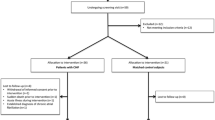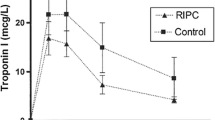Abstract
Exposure of one tissue to ischemia–reperfusion confers a systemic protective effect, referred to as remote ischemic preconditioning (RIPC). Confirmation that the desired effect of ischemia is occurring in tissues used to induce RIPC requires an objective demonstration before this technique can be used consistently in the clinical practice. Enrolled patients underwent three to four RIPC sessions on non-consecutive days. Sessions consisted of 4 cycles of 5 min of leg cuff inflation to 30 mmHg above the systolic blood pressure followed by reperfusion. Absence of leg pulse was confirmed by Doppler evaluation. To evaluate limb transient ischemia, patients were monitored with muscle microdialysis. Glucose, lactate, lactate/pyruvate ratio, and glycerol levels were measured. Fourteen microdialysis sessions were performed in seven patients undergoing RIPC (42.8 % male; mean age, 51.8; Fisher grade 4 in all seven patients, Hunt and Hess grade 5 in five patients, four in one patient and one in one patient). An average follow-up of 29 days demonstrated no complications associated with the procedure. Muscle microdialysis during RIPC sessions showed a significant increase in lactate/pyruvate ratio (21.2 to 26.8, p = 0.001) and lactate (3.0 to 3.9 mmol/L, p = 0.002), indicating muscle ischemia. There was no significant variation in glycerol (234 to 204 μg/L, p = 0.43), indicating no permanent cell damage. The RIPC protocol used in this study is safe, well tolerated, and induces transient metabolic changes consistent with sublethal ischemia. Muscle microdialysis can be used safely as a confirmatory tool in the induction of RIPC.

Similar content being viewed by others
References
Chen YS, Chien CT, Ma MC, Tseng YZ, Lin FY, Wang SS, et al. Protection "outside the box" (skeletal remote preconditioning) in rat model is triggered by free radical pathway. J Surg Res. 2005;126(1):92–101.
Dirnagl U, Simon RP, Hallenbeck JM. Ischemic tolerance and endogenous neuroprotection. Trends Neurosci. 2003;26(5):248–54.
Hausenloy DJ, Yellon DM. The evolving story of "conditioning" to protect against acute myocardial ischaemia–reperfusion injury. Heart. 2007;93(6):649–51.
Muramatsu H, Kariko K, Welsh FA. Induction of tolerance to focal ischemia in rat brain: dissociation between cortical lesioning and spreading depression. J Cereb Blood Flow Metab. 2004;24(10):1167–71.
Ren C, Yan Z, Wei D, Gao X, Chen X, Zhao H. Limb remote ischemic postconditioning protects against focal ischemia in rats. Brain Res. 2009;1288:88–94.
Kanoria S, Jalan R, Seifalian AM, Williams R, Davidson BR. Protocols and mechanisms for remote ischemic preconditioning: a novel method for reducing ischemia reperfusion injury. Transplantation. 2007;84(4):445–58.
Kharbanda RK, Mortensen UM, White PA, Kristiansen SB, Schmidt MR, Hoschtitzky JA, et al. Transient limb ischemia induces remote ischemic preconditioning in vivo. Circulation. 2002;106(23):2881–3.
Przyklenk K, Bauer B, Ovize M, Kloner RA, Whittaker P. Regional ischemic 'preconditioning' protects remote virgin myocardium from subsequent sustained coronary occlusion. Circulation. 1993;87(3):893–9.
Tapuria N, Kumar Y, Habib MM, Abu Amara M, Seifalian AM, Davidson BR. Remote ischemic preconditioning: a novel protective method from ischemia reperfusion injury—a review. J Surg Res. 2008;150(2):304–30.
Takagi H, Manabe H, Kawai N, Goto SN, Umemoto T. Review and meta-analysis of randomized controlled clinical trials of remote ischemic preconditioning in cardiovascular surgery. Am J Cardiol. 2008;102(11):1487–8.
Kloner RA. Clinical application of remote ischemic preconditioning. Circulation. 2009;119(6):776–8.
Chan MT, Boet R, Ng SC, Poon WS, Gin T. Effect of ischemic preconditioning on brain tissue gases and pH during temporary cerebral artery occlusion. Acta Neurochir Suppl. 2005;95:93–6.
Koch S, Katsnelson M, Dong C, Perez-Pinzon M. Remote ischemic limb preconditioning after subarachnoid hemorrhage: a phase Ib study of safety and feasibility. Stroke. 2011;42(5):1387–91. doi:10.1161/STROKEAHA.110.605840.
Konstantinov IE, Arab S, Kharbanda RK, Li J, Cheung MM, Cherepanov V, et al. The remote ischemic preconditioning stimulus modifies inflammatory gene expression in humans. Physiol Genomics. 2004;19(1):143–50.
Konstantinov IE, Arab S, Li J, Coles JG, Boscarino C, Mori A, et al. The remote ischemic preconditioning stimulus modifies gene expression in mouse myocardium. J Thorac Cardiovasc Surg. 2005;130(5):1326–32.
Dahl NA, Balfour WM. Prolonged anoxic survival due to anoxia pre-exposure: brain ATP, lactate, and pyruvate. A J Physiol. 1964;207(2):452.
Murry CE, Jennings RB, Reimer KA. Preconditioning with ischemia: a delay of lethal cell injury in ischemic myocardium. Circulation. 1986;74(5):1124–36.
Barone FC, White RF, Spera PA, Ellison J, Currie RW, Wang X, et al. Ischemic preconditioning and brain tolerance: temporal histological and functional outcomes, protein synthesis requirement, and interleukin-1 receptor antagonist and early gene expression. Stroke. 1998;29(9):1937–50.
Das M, Das DK. Molecular mechanism of preconditioning. IUBMB Life. 2008;60(4):199–203.
Janier MF, Vanoverschelde J, Bergmann SR. Ischemic preconditioning stimulates anaerobic glycolysis in the isolated rabbit heart. Am J Physiol Heart Circ Physiol. 1994;267(4):H1353.
Bolte CS, Liao S, Gross GJ, Schultz Jel J. Remote preconditioning-endocrine factors in organ protection against ischemic injury. Endocr Metab Immune Disord Drug Targets. 2007;7(3):167–75.
Hausenloy DJ, Yellon DM. Remote ischaemic preconditioning: underlying mechanisms and clinical application. Cardiovasc Res. 2008;79(3):377–86.
Kharbanda RK, Nielsen TT, Redington AN. Translation of remote ischaemic preconditioning into clinical practice. Lancet. 2009;374(9700):1557–65.
Oxman T, Arad M, Klein R, Avazov N, Rabinowitz B. Limb ischemia preconditions the heart against reperfusion tachyarrhythmia. Am J Physiol Heart Circ Physiol. 1997;273(4):H1707.
Birnbaum Y, Hale SL, Kloner RA. Ischemic preconditioning at a distance: reduction of myocardial infarct size by partial reduction of blood supply combined with rapid stimulation of the gastrocnemius muscle in the rabbit. Circulation. 1997;96(5):1641–6.
Sun XC, Li WB, Li QJ, Zhang M, Xian XH, Qi J, et al. Limb ischemic preconditioning induces brain ischemic tolerance via p38 MAPK. Brain Res. 2006;1084(1):165–74.
Ren C, Gao X, Steinberg GK, Zhao H. Limb remote-preconditioning protects against focal ischemia in rats and contradicts the dogma of therapeutic time windows for preconditioning. Neuroscience. 2008;151(4):1099–103.
Loukogeorgakis SP, Panagiotidou AT, Broadhead MW, Donald A, Deanfield JE, MacAllister RJ. Remote ischemic preconditioning provides early and late protection against endothelial ischemia–reperfusion injury in humans: role of the autonomic nervous system. J Am Coll Cardiol. 2005;46(3):450–6.
Cheung MM, Kharbanda RK, Konstantinov IE, Shimizu M, Frndova H, Li J, et al. Randomized controlled trial of the effects of remote ischemic preconditioning on children undergoing cardiac surgery: first clinical application in humans. J Am Coll Cardiol. 2006;47(11):2277–82.
Hausenloy DJ, Mwamure PK, Venugopal V, Harris J, Barnard M, Grundy E, et al. Effect of remote ischaemic preconditioning on myocardial injury in patients undergoing coronary artery bypass graft surgery: a randomised controlled trial. Lancet. 2007;370(9587):575–9.
Ali ZA, Callaghan CJ, Lim E, Ali AA, Nouraei SA, Akthar AM, et al. Remote ischemic preconditioning reduces myocardial and renal injury after elective abdominal aortic aneurysm repair: a randomized controlled trial. Circulation. 2007;116(11 Suppl):I98–105.
Hoole SP, Heck PM, Sharples L, Khan SN, Duehmke R, Densem CG, et al. Cardiac Remote Ischemic Preconditioning in Coronary Stenting (CRISP Stent) Study: a prospective, randomized control trial. Circulation. 2009;119(6):820–7.
Venugopal V, Hausenloy DJ, Ludman A, Di Salvo C, Kolvekar S, Yap J, et al. Remote ischaemic preconditioning reduces myocardial injury in patients undergoing cardiac surgery with cold-blood cardioplegia: a randomised controlled trial. Heart. 2009;95(19):1567–71.
Botker HE, Kharbanda R, Schmidt MR, Bottcher M, Kaltoft AK, Terkelsen CJ, et al. Remote ischaemic conditioning before hospital admission, as a complement to angioplasty, and effect on myocardial salvage in patients with acute myocardial infarction: a randomised trial. Lancet. 2010;375(9716):727–34.
Muller M, Schmid R, Nieszpaur-Los M, Fassolt A, Lonnroth P, Fasching P, et al. Key metabolite kinetics in human skeletal muscle during ischaemia and reperfusion: measurement by microdialysis. Eur J Clin Investig. 1995;25(8):601–7.
Korth U, Merkel G, Fernandez FF, Jandewerth O, Dogan G, Koch T, et al. Tourniquet-induced changes of energy metabolism in human skeletal muscle monitored by microdialysis. Anesthesiology. 2000;93(6):1407.
Ostman B, Michaelsson K, Rahme H, Hillered L. Tourniquet-induced ischemia and reperfusion in human skeletal muscle. Clin Orthop Relat Res. 2004;418:260.
Desvigne N, Barthelemy JC, Bertholon F, Gay-Montchamp JP, Freyssenet D, Costes F. Validation of a new calibration method for human muscle icrodialysis at rest and during exercise. Eur J Appl Physiol. 2004;92:312–20.
Hansen DK, Davies MI, Lunte SM, Lunte CE. Pharmacokinetic and metabolism studies using microdialysis sampling. J Pharm Sci. 1999;88(1):14–27.
Davies MI, Cooper JD, Desmond SS, Lunte CE, Lunte SM. Analytical considerations for microdialysis sampling. Adv Drug Deliv Rev. 2000;45(2–3):169–88.
Rosdahl H, Ungerstedt U, Jorfeldt L, Henriksson J. Interstitial glucose and lactate balance in human skeletal muscle and adipose tissue studied by microdialysis. J Physiol. 1993;471(1):637.
Rosdahl H, Hamrin K, Ungerstedt U, Henriksson J. Metabolite levels in human skeletal muscle and adipose tissue studied with microdialysis at low perfusion flow. Am J Physiol Endocrinol Metab. 1998;274(5):E936–E45.
Ren G, Eiskjaer S, Kaspersen J, Christensen FB, Rasmussen S. Microdialysis of paraspinal muscle in healthy volunteers and patients underwent posterior lumbar fusion surgery. Eur Spine J. 2009;18(11):1604–9.
Ungerstedt U. Microdialysis—principles and applications for studies in animals and man. J Intern Med. 1991;230(4):365–73.
Birke-Sorensen H, Toft G, Bengaard J. Pure muscle transfers can be monitored by use of microdialysis. J Reconstr Microsurg. 2010;26(9):623–9.
Conflict of Interest
The authors declare that they have no conflict of interest.
Support Acknowledgments
NRG research supported by the Ruth and Raymond Stotter Chair Endowment in Neurosurgery.
Author information
Authors and Affiliations
Corresponding author
Rights and permissions
About this article
Cite this article
Bilgin-Freiert, A., Dusick, J.R., Stein, N.R. et al. Muscle Microdialysis to Confirm Sublethal Ischemia in the Induction of Remote Ischemic Preconditioning. Transl. Stroke Res. 3, 266–272 (2012). https://doi.org/10.1007/s12975-012-0153-1
Received:
Revised:
Accepted:
Published:
Issue Date:
DOI: https://doi.org/10.1007/s12975-012-0153-1




